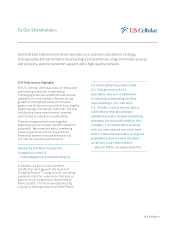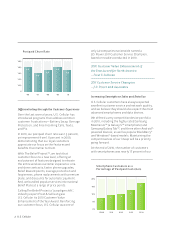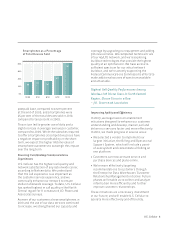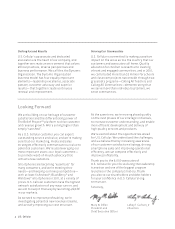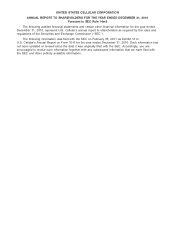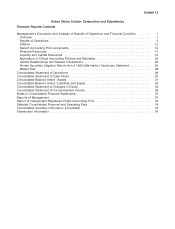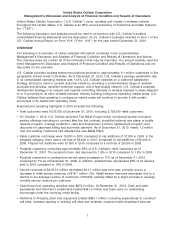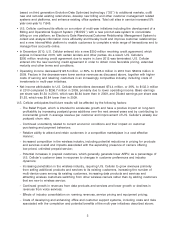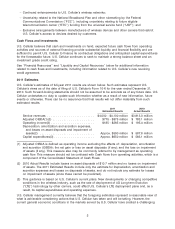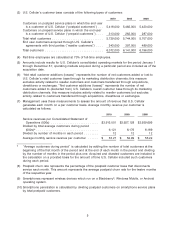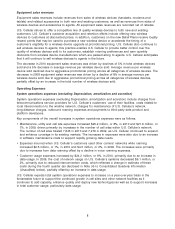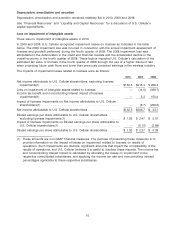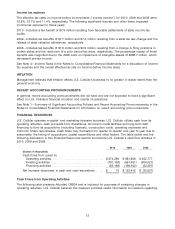US Cellular 2010 Annual Report Download - page 10
Download and view the complete annual report
Please find page 10 of the 2010 US Cellular annual report below. You can navigate through the pages in the report by either clicking on the pages listed below, or by using the keyword search tool below to find specific information within the annual report.based on third generation Evolution-Data Optimized technology (‘‘3G’’) to additional markets, outfit
new and remodel existing retail stores, develop new billing and other customer management related
systems and platforms, and enhance existing office systems. Total cell sites in service increased 5%
year-over-year to 7,645.
• U.S. Cellular continued its efforts on a number of multi-year initiatives including the development of a
Billing and Operational Support System (‘‘B/OSS’’) with a new point-of-sale system to consolidate
billing on one platform; an Electronic Data Warehouse/Customer Relationship Management System to
collect and analyze information more efficiently and thereby build and improve customer relationships;
and a new Internet/Web platform to enable customers to complete a wide range of transactions and to
manage their accounts online.
• In December 2010, U.S. Cellular entered into a new $300 million revolving credit agreement, which
expires in December 2015, with certain lenders and other parties. As a result, U.S. Cellular’s
$300 million revolving credit agreement due to expire in June 2012 was terminated. U.S. Cellular
entered into the new revolving credit agreement in order to obtain more favorable pricing, extended
maturity and other terms and conditions.
• Operating income decreased $125.5 million, or 39%, to $195.4 million in 2010 from $320.9 million in
2009. Factors in the decrease were lower service revenues as discussed above, together with higher
costs of serving and retaining customers in an increasingly competitive industry, including costs of
investments in multi-year initiatives.
• Net income attributable to U.S. Cellular shareholders decreased $74.4 million, or 36%, to $132.3 million
in 2010 compared to $206.7 million in 2009, primarily due to lower operating income. Basic earnings
per share was $1.54 in 2010, which was $0.84 lower than in 2009, and Diluted earnings per share was
$1.53, which was $0.84 lower than in 2009.
U.S. Cellular anticipates that future results will be affected by the following factors:
– The Belief Project, which is intended to accelerate growth and have a positive impact on long-term
profitability by increasing postpaid gross additions over the next several years and by contributing to
incremental growth in average revenue per customer and improvement of U.S. Cellular’s already low
postpaid churn rate;
– Continued uncertainty related to current economic conditions and their impact on customer
purchasing and payment behaviors;
– Relative ability to attract and retain customers in a competitive marketplace in a cost effective
manner;
– Increased competition in the wireless industry, including potential reductions in pricing for products
and services overall and impacts associated with the expanding presence of carriers offering
low-priced, unlimited prepaid service;
– Potential increases in prepaid customers, which generally generate lower ARPU, as a percentage of
U.S. Cellular’s customer base in response to changes in customer preferences and industry
dynamics;
– Increasing penetration in the wireless industry, requiring U.S. Cellular to grow revenues primarily
from selling additional products and services to its existing customers, increasing the number of
multi-device users among its existing customers, increasing data products and services and
attracting wireless customers switching from other wireless carriers rather than by adding customers
that are new to wireless service;
– Continued growth in revenues from data products and services and lower growth or declines in
revenues from voice services;
– Effects of industry consolidation on roaming revenues, service pricing and equipment pricing;
– Costs of developing and enhancing office and customer support systems, including costs and risks
associated with the completion and potential benefits of the multi-year initiatives described above;
2



